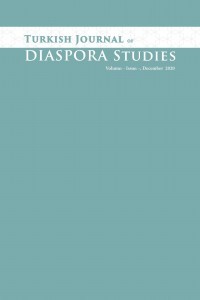Migration and Human Trafficking: A Case Study of the Deceptive Sub-Saharan African Women in Turkey
Migration and Human Trafficking: A Case Study of the Deceptive Sub-Saharan African Women in Turkey
Since the mid-1990s, Turkey has experienced a massive increase in sub-Saharan African migrants. According to the U.S. Department of State’s 2021 report on trafficking in Turkey, in 2019, there were 276 victims of human trafficking. This paper examines the issue of human trafficking through the lens of the concept of deceptive trafficking. The cases of eight victimized women trafficked to Turkey from sub-Saharan Africa are examined, and their responses are thematically analyzed using migration theories with a focus on Van Hear’s model. The testimonies of these sub-Saharan African women exploited by human traffickers serve as the foundation for this study. The paper reveals the circumstances that give rise to the practice of human trafficking and the factors that maintain its existence in sub-Saharan African countries. The results highlighted the vulnerability of African women as a target for international and transnational human trafficking.
Keywords:
Human Trafficking, Migration, Gender Deception,
___
- Adepoju, A. (2005). Review on research and data on human trafficking in sub-Saharan Africa. International Migration. Doi:10.1111/j.0020-7985.2005.00313.x
- Adetula V. (2014). African Conflicts, Development and Regional Organizations in Post-Cold War International System. The Annual Claude Ake Memorial Lecture. The Nordic Africa, https://www.files.ethz.ch/isn/189693/FULLTEXT03.pdf.
- Armitage, A. (2010) From Conscientization, Dialogue and Collaborative Problem Based Learning to a critical HRM pedagogy, Journal of Problem Base Learning in Higher Education. European, Vol.1, No.1/2013, pp.1-18. Doi: https://files.eric.ed.gov/fulltext/EJ1108329.pdf
- Avdan, N. (2012). Human trafficking and migration control policy: vicious or virtuous cycle? Journal of Public Policy, 32(3), 171–205. Doi: http://www.jstor.org/stable/23351562
- Baldwin-Edwards, M. (2006). “Between a Rock & a Hard Place”: North Africa as a Region of Emigration, Immigration & Transit Migration. Review of African Political Economy, 33(108), 311–324. Doi: http://www.jstor.org/stable/4007166
- Brewer, K. and Yükseker, D. 2011. Astray and stranded at the gates of the European Union: African transit migrants in Istanbul. Doi:10.1017/S0896634600005963
- Brockerhoff, M., & Brennan, E. (1998). The Poverty of Cities in Developing Regions. Population and Development Review, 24(1), 75–114. Doi: https://doi.org/10.2307/2808123
- Cuttitta, P., & Last, T. (Eds.). (2020). Border Deaths: Causes, Dynamics, and Consequences of Migration-related Mortality. Amsterdam University Press. Doi: https://doi.org/10.2307/j.ctvt1sgz6
- Flahaux, ML., De Haas, H. (2016). African migration: trends, patterns, drivers. CMS 4, 1. Doi: https://doi.org/10.1186/s40878-015-0015-6
- Global Slavery Index Report, (2022). Global Slavery Index/Regional Findings Africa. Doi:https://www.walkfree.org/global-slavery-index/findings/regional-findings/africa/
- Goldschmidt, A., (2006). Storming the Fences: Morocco and Europe's Anti-Migration Policy. Doi:https://www.researchgate.net/publication/274043874_Storming_the_Fences_Morocco_and_Europe's_Anti-Migration_Policy
- Gould, F, Vella, M. R., Lloyd, A. L., & Dhole, S. (2018). Invasion and migration of spatially self-limiting gene drives: A comparative analysis. Evolutionary applications, 11(5), 794–808. Doi: https://doi.org/10.1111/eva.12583
- International Labour Organization, Walk Free & International Organization for Migration 2022, Global Estimates of Modern Slavery: Forced Labour and Forced Marriage. Doi:https://cdn.walkfree.org/content/uploads/2022/09/12142341/GEMS 2022_Report_EN_V8.pdf
- International Labour Organization (ILO) 2003 Report on The Trafficking of Women and Children in the Southern African Region, Presentation of Research Findings, ILO, Geneva, 24 March. Doi: https://www.ilo.org/public/english/standards/relm/rgmeet/10afrm/dg-rep.pdf
- IOM, (2013) Report on Human trafficking in migration pathways: trends, challenges, and new forms of cooperation, https://publications.int/system/files/pdf/wmr2013_en.pd
- IOM, (2020). Africa and the Middle East Migration. Doi: https://www.iom.int/africa-and-middle-east Jahic, G., & Finckenauer, J. O. (2005). Representations and misrepresentations of human trafficking. Trends in Organized Crime, 8(3), 24-40.
- Kelly, L. (2004). The Perils of Inclusion and Exclusion: International Debates on the Status of Trafficked Women as Victims. International Review of Victimology, 11(1), 33–47. Doi: https://doi.org/10.1177/026975800401100103
- McIntyre, A. (2002). Exploring Whiteness and Multicultural Education with Prospective Teachers. Curriculum Inquiry, 32(1), 31–49. Doi: http://www.jstor.org/stable/3202189.
- Mike Dottridge. (2002). Trafficking in Children in West and Central Africa. Gender and Development, 10(1), 38–42. Doi: http://www.jstor.org/stable/4030680
- Moore, H. 1994 “Is there a crisis in the family?”, Occasional Paper No.3, World Summit for Social Development, UNRISD, Geneva. Doi:https://www.econstor.eu/bitstream/10419/148807/1/862975204.pdf
- O. Bello, P., & A. Olutola, A. (2021). The Conundrum of Human Trafficking in Africa. Intech Open. Doi:10.5772/intechopen.83820
- O’Brien, R. (2001). An Overview of the Methodological Approach of Action Research in Teoria. Doi: https://base.socioeco.org/docs/overview_of_action_research_method
- Oluwaniyi, O. (2009). Children and Youth in the Labour Process in Africa. Doi: https://books.google.ca/books?hl=en&lr=&id=42Gr1_yfrocC&oi=fnd
- Şaul, M. (2017). The migrant in a plotted adventure: Self-realisation and moral obligation in African stories from Istanbul. The Journal of Modern African Studies, 55(1), 129–153. Doi: http://www.jstor.org/stable/26309803
- Turkish Ministry of Interior, (2020) Presidency of Migration Management. Doi: https://en.goc.gov.tr/
- United Nations, (2000). Protocol to Prevent, Suppress and Punish Trafficking in Persons Especially Women and Children, supplementing the United Nations Convention against Transnational Organized Crime. Doi: https://www.ohchr.org/en/instruments-mechanisms/instruments/protocol-prevent-suppress-and-punish-trafficking-persons
- United States: Department of State, 2022 Trafficking in Persons Report. Doi:https://www.state.gov/reports/2022-trafficking-in-persons-report/
- United States: Department of States; 2021 Trafficking in Persons Report: Turkey. Doi:https://www.state.gov/reports/2021-trafficking-in-persons-report/turkey/
- UNHCR, (2020). Report on Human Trafficking and Sexual Exploitation. Doi:https://www.unhcr.org/what-we-do/protect-human-rights/asylum-and-migration/trafficking-persons
- UN-HABITAT, (2020). World Cities Report 2020. The Value of Sustainable Urbanization. Doi: https://unhabitat.org/sites/default/files/2020/10/wcr_2020_report.pdf
- UNICEF, (2020). Annual Report on Trafficking in Sub-Saharan African Countries. Doi: https://www.unicef.org/wca/topics/migration
- UNODC. (2020). Global Report on Trafficking in Persons. Office on Drugs and Crime. Doi:https://www.unodc.org/documents/data-and-analysis/tip/2021/GLOTiP_2020_15jan_web.pdf
- UNODC, (2022). Report on Trafficking in Persons. Office on Drugs and Crime. Doi: https://www.unodc.org/unodc/data-and-analysis/glotip.html
- Van Hear, N. (1998). New Diasporas: The Mass Exodus, Dispersal and Regrouping of Migrant Communities. UCL Press, London, 1998. Doi: https://worldcat.org/oclc/316130669
- World Banka Data (2020). Report on Literacy Rate in Sub-Saharan Africa. Doi: https://data.worldbank.org/country/ZG
- Wijers, M. & M. van Doorninck (2002). ‘Only right can stop wrongs: A critical assessment of anti-trafficking strategies’, Paper presented at the meeting of the EC-IOM Stop Conference. Brussels: IOM. Doi: https://www.nswp.org/es/node/150
- Zulu, E.M., Beguy, D., Ezeh, A.C. et al., (2011) Overview of migration, poverty, and health dynamics in Nairobi City's slum settlements. J Urban Health 88 (Suppl 2), 185–199 (2011). https://doi.org/10.1007/s11524-011-9595-0
- ISSN: 2717-7408
- Yayın Aralığı: Yılda 2 Sayı
- Başlangıç: 2021
- Yayıncı: Göç Araştırmaları Vakfı
